The Intel 6th Gen Skylake Review: Core i7-6700K and i5-6600K Tested
by Ian Cutress on August 5, 2015 8:00 AM ESTWhat You Can Buy: Office and Web Benchmarks
For the last segment of graphs, we have the same data as the previous few generational pages but we have also included other processors from our database for non-standard comparisons.
All of our benchmark results can also be found in our benchmark engine, Bench.
Office Performance
Dolphin Benchmark: link
Many emulators are often bound by single thread CPU performance, and general reports tended to suggest that Haswell provided a significant boost to emulator performance. This benchmark runs a Wii program that raytraces a complex 3D scene inside the Dolphin Wii emulator. Performance on this benchmark is a good proxy of the speed of Dolphin CPU emulation, which is an intensive single core task using most aspects of a CPU. Results are given in minutes, where the Wii itself scores 17.53 minutes.
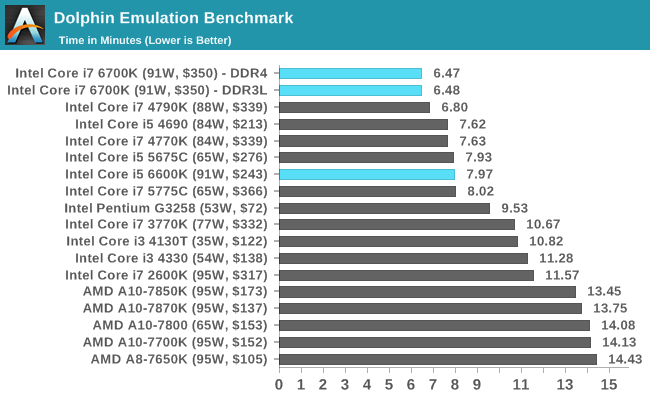
WinRAR 5.0.1: link
Our WinRAR test from 2013 is updated to the latest version of WinRAR at the start of 2014. We compress a set of 2867 files across 320 folders totaling 1.52 GB in size – 95% of these files are small typical website files, and the rest (90% of the size) are small 30 second 720p videos.
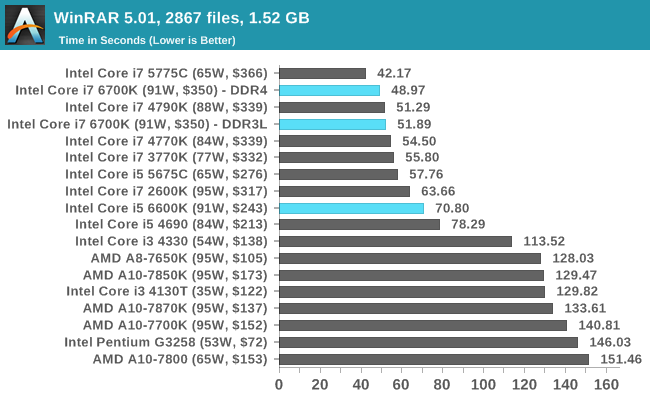
3D Particle Movement
3DPM is a self-penned benchmark, taking basic 3D movement algorithms used in Brownian Motion simulations and testing them for speed. High floating point performance, MHz and IPC wins in the single thread version, whereas the multithread version has to handle the threads and loves more cores.
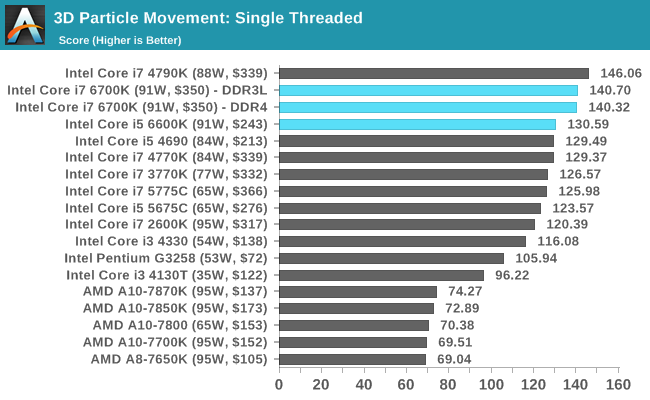
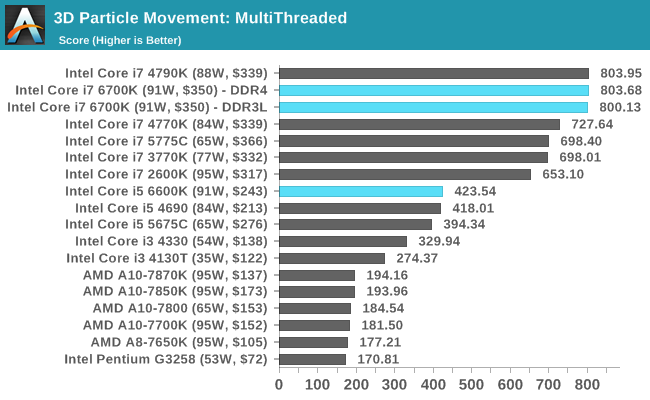
FastStone Image Viewer 4.9
FastStone is the program I use to perform quick or bulk actions on images, such as resizing, adjusting for color and cropping. In our test we take a series of 170 images in various sizes and formats and convert them all into 640x480 .gif files, maintaining the aspect ratio. FastStone does not use multithreading for this test, and results are given in seconds.
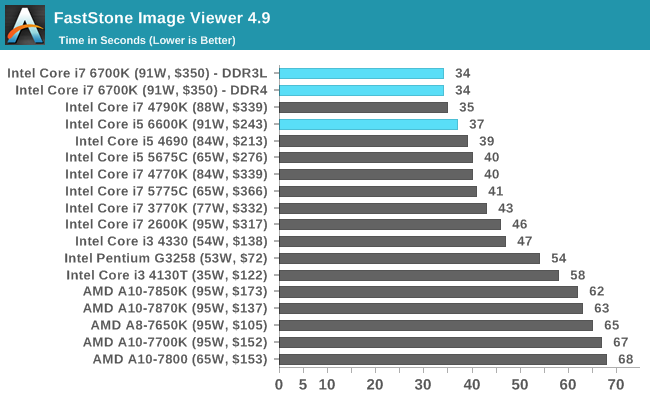
Web Benchmarks
On the lower end processors, general usability is a big factor of experience, especially as we move into the HTML5 era of web browsing. For our web benchmarks, we take four well known tests with Chrome 35 as a consistent browser.
Sunspider 1.0.2
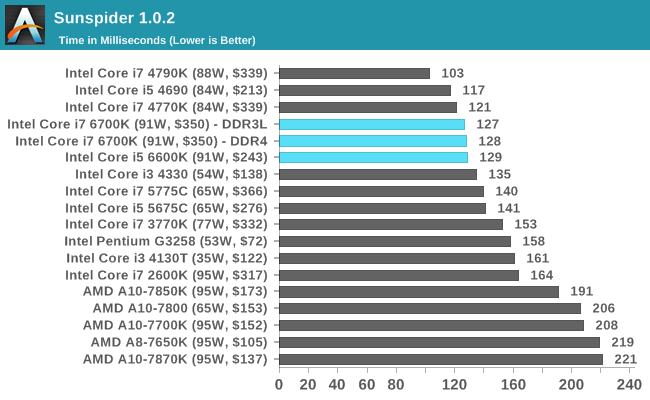
Mozilla Kraken 1.1
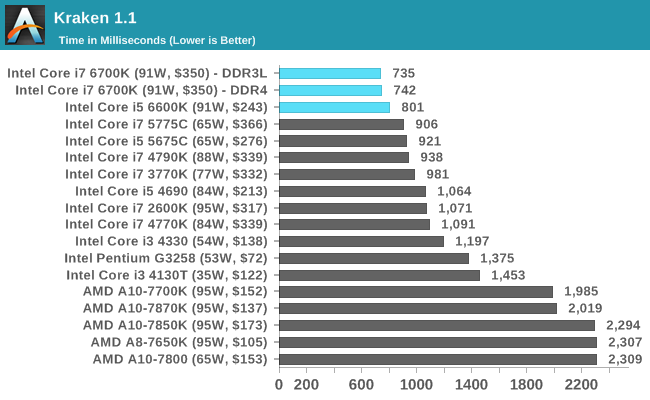
WebXPRT
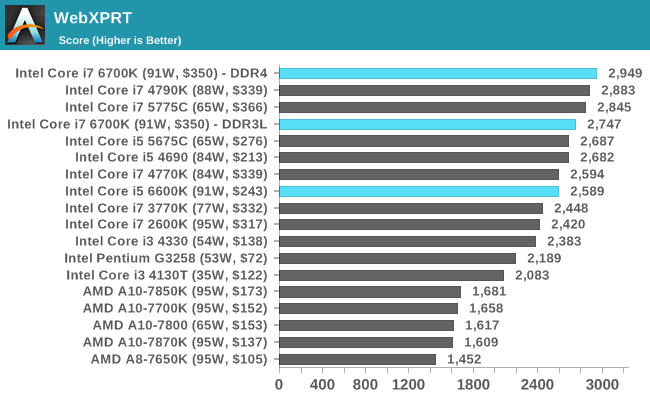
Google Octane v2
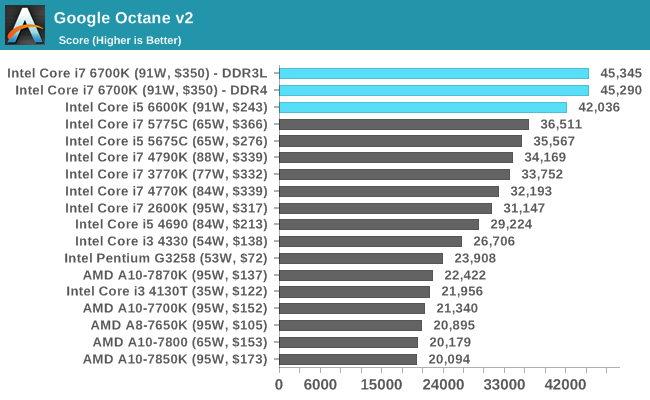










477 Comments
View All Comments
vdek - Thursday, August 6, 2015 - link
I'm still running my x58 motherboard. I ended up upgrading to a Xeon 5650 for $75, which is a 6 core 32nm CPU compatible with the x58. Overclocked at 4.2ghz on air, the thing has excellent gaming performance, I see absolutely no reason to upgrade to Skylake.bischofs - Thursday, August 6, 2015 - link
Absolutely agree, My overclocked 920 still runs like a watch after 8 years. Not sure what Intel is doing these days, but lack of competition is really impacting this market.stux - Friday, August 7, 2015 - link
I upgraded my 920 to a 990x, it runs at about 4.4ghz on air in an XPC chassis! and has 6/12 cores.I bought it off ebay cheap, and with an SSD on a SATA3 card I see no reason to upgrade. It works fantastically well, and is pretty much as fast as any modern 4 core machine.
Samus - Sunday, October 25, 2015 - link
If you single GPU and don't go ultra-high-end then gaming is still relevant on x58, but it really isn't capable of SLI due to PCIe 2.0 and the lanes being reduced to 8x electrical when more than one 16x length slot is used. QPI also isn't very efficient by todays standards and at the time, AMD still had a better on-die memory controller, but Intel's first attempt was commendable, but completely overhauled with Sandy Bridge which offered virtually the same performance from 2 channels. Anybody who has run dual channel on X58 knows how bad it actually is and why triple channel is needed to keep it competitive with todays platforms.I loved X58. It is undoubtedly the most stable platform I'd had since the 440BX. But as I said, by todays standards, it makes Sandy Bridge seem groundbreaking, not because of the IPC, but because of the chipset platform. The reduced power consumption, simplicity and overall smaller-size and lower cost of 60/70 series chipsets, then the incredibly simplified VRM layout in 80/90 chipsets (due to the ondie FIVR of Haswell) makes X58 "look" ancient, but as I said, still relevant.
Just don't load up the PCIe bus. A GPU, sound card and USB 3.0 controller is about as far as you want to go, and for the most part, as far as you need too!
vdek - Thursday, August 6, 2015 - link
Get a Xeon 5650, 6 core CPU, 32nm, will run at 4-4.2ghz all day on air. I upgraded my i7 920 the X5650 and I couldn't be happier. They go for about $70-80 on amazon or ebay. I'm planning on keeping my desktop for another 2-3 years, I upgraded the GPU to a GTX970 and it maxes out most of what I can throw at it. I don't really see my CPU as a bottleneck here.mdw9604 - Tuesday, August 11, 2015 - link
Can you OC a Xeon 5650?mapesdhs - Wednesday, August 12, 2015 - link
Of course, back then the main oc'ing method was still bclk-based based, though X58 was a little more involved than that compared to P55 (uncore, etc.)LCTR - Saturday, August 15, 2015 - link
I'd been pondering the 6700K until I saw these posts from 920 users :)I use mine for gaming / video editing, it's running non-hyperthreaded at 4.2GHz on air (about 4Ghz with HT on)
I also upgraded my GPU to a 970 and have seen decent gaming performance - if I could jump to a X5650 and stretch things for 1-2 years that'd be great...
What sort of performance do you see from the X5650? Would it win 4GHz with HT enabled?
The Xeon 5650's don't need any special mobo support or anything, do they? I have a gigabyte GA-EX58-UD5
Nfarce - Wednesday, August 5, 2015 - link
Well sadly, ever since SB (which I have one that's 4 years old, a 2500K, alongside a newer Haswell 4690K, each new tick/tock has not been much. The days of getting 50% boost in performance between a few generations are long gone, let alone 100% boost, or doubling performance. Also keep in mind that there is a reason for this decrease in increased performance: as dies shrink, physics with electrons start becoming an issue. Intel has been focusing more on decreased power usage. At some point CPU manufacturers will need to look at an entirely different manufacturing material and design as silicon and traditional PCB design is coming to its limit.Mr Perfect - Wednesday, August 5, 2015 - link
It's not even 30% in high-end gaming. There is a clear improvement between SB and Skylake, but why should I build a whole new PC for 5FPS? I can't justify that expense.I'd be curious to see the high-end gaming benchmarks rerun with the next generation of GPUs. Will next gen GPUs care more about the CPU, or does DX12 eliminate the difference altogether?